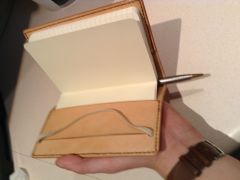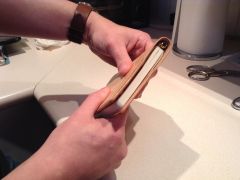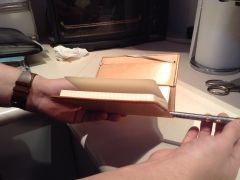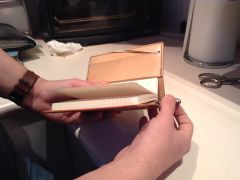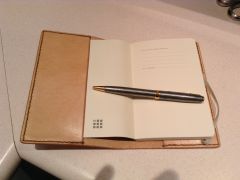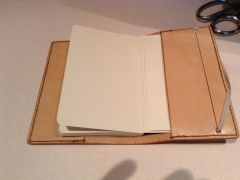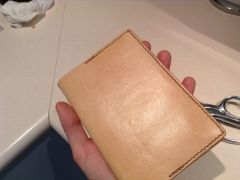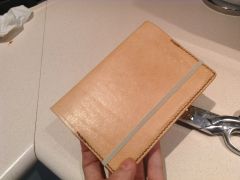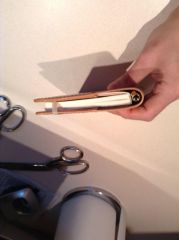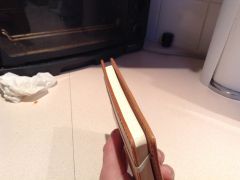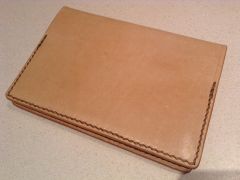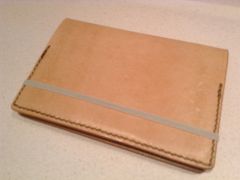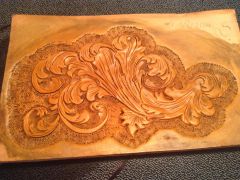-
Posts
110 -
Joined
-
Last visited
Content Type
Profiles
Forums
Events
Blogs
Gallery
Everything posted by Avgvstvs
-
Waterhouse leather offers a free skiving/splitting service too.
-

Document Case
Avgvstvs replied to VanPutter's topic in Purses, Wallets, Belts and Miscellaneous Pocket Items
Nice job! Clean construction and nice stitching indeed! -
From the album: Veg tan moleskine cover
-
From the album: Veg tan moleskine cover
-
From the album: Veg tan moleskine cover
-
From the album: Veg tan moleskine cover
-
From the album: Veg tan moleskine cover
-
From the album: Veg tan moleskine cover
-
From the album: Veg tan moleskine cover
-
From the album: Veg tan moleskine cover
-
From the album: Veg tan moleskine cover
-
From the album: Veg tan moleskine cover
-
From the album: Veg tan moleskine cover
-
From the album: Veg tan moleskine cover
-
I guess you're right... There might not be any way to control the heat... The description on proleptic's site is quite lacking - I just sent them a few questions. Will post the answers when they get back to me.
-
Hi all, I recall reading that some people were looking for an alternative to the 'fileteuse manuelle' tool. I recently stumbled upon proleptic's website and came across this: Complete kit: https://proleptic.net/shop/pro-thermal-tools/complete-pro-thermal-tool-kit/ All pro-termal items: https://proleptic.net/product-category/tools/pro-thermal-tools/?orderby=price-desc The complete kit is retailed at $170. The tool is sold by itself for $35 and the tips range from $18 to $30. Information on the site (and anywhere else) is quite limited but it looks to me like it might be more adapted to leatherworking than soldering irons or pyrography tools. Has anyone used these pro-thermal tools? It would be great to hear what people have to say about them...
-
Your bag is amazing! That's a nice design - sophisticated, elegant and truly imaginative. You work really stands out. Like DavidL, I think designs like this one and that of the satchel you posted a while back have a high-end luxury leather good type of look. I rarely see original designs that have that refined and classy look. Usually it's just too much to my eye. And, like many have stated before, I don't think your design is rugged or rough, I find it's quite the opposite!
-
Hi nuttish, I can't speak based on long-term experience as I'm just a beginner at leatherwork. The edges seem to hold on the (crude) item I made for myself. I made several items for family and friends using the sole and edge dressing to finish the edges but more time will be needed before I can be absolutely positive about the durability of those edges. The edges of the scrap piece with finished edges I posted earlier have been rubbed vigorously against jeans for about a minute (I did that to test the result before using the product on a finished item). The finish created on the edges is not as close to burnishing edges as it is to painting them (but it's more like a stain+varnish type of thing rather than paint). The product soaks in the leather and hardens it. This allows you to have more control over the sanding you do and when you put on the final coat(s) it bonds with the hardened edge. I suspect that the fact that the liquid hardens in the leather helps those edges to be more durable than regular painted edges (I own several articles with painted edges and the finish cracked and rubbed off them all quite fast after normal use). As for the leather I got, I'm pretty sure it's chromexcel; it's what I paid for (from Maverick) and it smells, feels and looks like chromexcel. I have never played with either essex or dublin but from what I gather, it shouldn't be so easy to confuse chromexcel for dublin or essex as I have read in a post from Nick Horween that essex is essentially cowhide tanned with the same extracts as shell cordovan and dublin is basically a waxed essex.
-
Hi Nuttish. I bevel the edges with a craptool edge beveler I got in a beginner's kit from Tandy. The thing isn't sharp - I never sharpened it and you know 'sharp' is hardly a word one could use to describe those tools. To minimize the drag when beveling chromexcel, put as little pressure as possible on the tool, it should make a significant difference. Also, I noticed that the angle at which you hold the beveler has a great impact on the level of drag you get while beveling. Another thing to note is, if your chromexcel is of 'second' quality, the 'loose grained' parts will tend to drag significantly more as the grain is detached from the flesh part in some areas. I hope this helps. Word to the wise: as I stated earlier, this method is atrociously tedious; it takes me about 2-3x more time to finish edges that way vs finishing straight veg tanned leather edges. PS: Widget (or anyone else) If you decide to try this method, I would greatly appreciate to get feedback from you as I probably haven't nailed the most efficient way to go about it and I suppose I could learn a great deal from other's experiences with the techique/ product.
-

Lots Of Questions About Tooling/forming Leather
Avgvstvs replied to niteshiftfromkc's topic in How Do I Do That?
In all honesty, I'm really not all that knowledgeable on the subject. My suggestion would be more adapted to a situation where you mold one piece in order to sew it on another one. You would have the backside free and could stitch without any problems. Now if your item is made of a single molded piece or it's made out of two pieces already sewn, it's another story completely. On the matter of shortening the needles, I suppose you could trim them down a little and then file and polish the tip so it's blunt and won't catch the leather or thread when in use. Sounds like a lot of work for needles... -

Lots Of Questions About Tooling/forming Leather
Avgvstvs replied to niteshiftfromkc's topic in How Do I Do That?
It might not be such a great idea but I figured I should post it if it can have a slight chance to help... How about integrating the tooling to the wet formed item as an appliqué, i.e. tooling another piece and then glue and stitch it to the item? -

First go at tooling - Acanthus leaf with antique finish
Avgvstvs posted a gallery image in Gallery- Our Leatherwork
From the album: Test
-
From the album: Test
-
The above is copied and pasted from the abbey website's description of the threads. I think they just goofed up and didn't describe their products consistently. I don't think there's any difference. Then again, English is not my mother tongue so I might be missing something.
-
I don't know about the wax level. What I see at abbey is either Ritza 25 (the one I referred to earlier) and Ritza 44. On the julius Koch site, Ritza 44 is advertised as machine sewing thread and is silicone lubricated (ranges 0.6mm-0.8mm) whereas Ritza 25 is described as hand sewing thread (ranges 0.8mm-1.2mm). Abbey lists them slightly differently (and oddly enough stocks sizes outside of the range advertised on the Julius Koch website): -Ritza 25 this is (a) very strong braided polyester thread which is waxed for hand sewing -Ritza 44 this is (a) very strong braided polyester thread which is waxed for hand stitching leather Abbey might have their spools made on 'special specs' - there could be a difference in wax level applied on the thread. I don't know if they meant to phrase it another way. Never used ritza 44 but it seems to come in only 3 colors (mid-brown, brown and black). The upside of the 44 would be that it comes in 0.4mm for fine work - I didn't know that!

.jpg.d60258221c476480a6e073a8805645bb.jpg)

